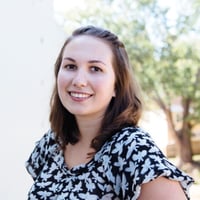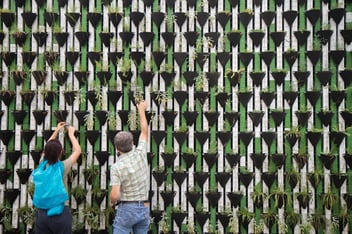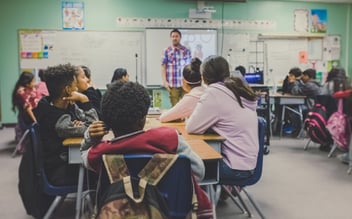Over the past two decades, a new methodology known as photovoice has emerged on the anthropological, documentary, and public-health scenes. More recently, it has been used within the field of service-learning. When a service-learning curriculum is coupled with the photovoice methodology, students can be better engaged with the course material and their volunteer experiences. Using John Wood’s course There and Back Again: An Anthropology of Witness as our model, we will explore the benefits of photovoice and briefly discuss how to implement a similar methodology in the classroom.
What is Photovoice?
Photovoice is a form of participatory action research in which the traditional subjects of photographs become the photographers. By using community-based research activities, the photovoice methodology is designed to empower people who are marginalized or silenced by mainstream society, whether for their race, culture, class, disability, sexuality, or another reason that labels them ‘Other’ (Palibroda, Krieg, Murdock, & Havelock 8). These groups then work together to “identify, represent, and enhance their community through a specific photographic technique” that is “based on the theoretical literature on education for critical consciousness, feminist theory, and nontraditional approaches to documentary photography (Wang and Burris 185).
Photovoice allows members of marginalized groups the opportunity to tell their own story, and contribute their own voices to the narrative that surrounds them. By giving these individuals cameras to document their experiences, they can create photographic evidence that will allow for insight into the way they see their communities and the world (Palibroda, Krieg, Murdock, & Havelock 8). Photovoice projects typically culminate in an exhibition of the photographs, which encourages critical community dialogue, empowerment, and action (Hernandez, Shabazian, & Mcgrath 1948).
The History of Photovoice
Photovoice is a relatively new concept in education. In 1992, Caroline Wang from the University of Michigan conceptualized “a process by which people can identify, represent, and enhance their community through a specific photographic technique.” She originally called this practice photo novella (Ross,1948).
Wang and her partner, Mary Ann Burris, first used this methodology with women in the rural Yunnan Province of China. They gave the women cameras and asked them to depict their lives and environment over the course of a year. At regular intervals, they met to view and discuss their photos as a group. The project concluded in a photo exhibition, viewed by both the public and policymakers, that addressed the policies and programs that affected the women (Rabinowitz).
Since then, photovoice has been used in communities all over the world. It’s been implemented by refugees in San Diego who sought in-person medical interpretation programs. It was harnessed by Dr. Laura S. Lorenz to support her work with brain-injury survivors (Strack, Magill, & McDonagh 49-58). And in 2016, it was used by John Wood, Ph.D, at the University of North Carolina at Asheville, to promote the healing of Vietnam veterans. In this paper, Wood’s course will serve as the primary example and illustration of this methodology in action.
The Benefits of Incorporating Photovoice Methodology into Service-Learning
According to a study by Scientific Research Publishing, teaching that connects students’ lives to their educational pursuits results in increased learning potential. This link can be effectively solidified through the educational approach of service-learning (Hernandez, Shabazian, & Mcgrath 1949). This non-traditional model is “a form of experiential education in which students engage in activities that address human and community needs together with structured opportunities intentionally designed to promote student learning and development. Reflection and reciprocity are key concepts of service-learning” (Jacoby 5).
As our exploration of Wood’s course project will show, photovoice—like service-learning—also connects academic study (reading texts and examining photos produced by a community) with community service (working with individuals to effect policy change and critical dialogue within the larger community). When asked about the link between service-learning and photovoice, Wood explained, “The whole idea is to be in service of communities, to help communities themselves tell a story they want to tell. […] You work with communities that say ‘we want to make sure that people understand this about us,’ or ‘we want people to know that we’re being hammered by this industry,’ or ‘we want people to know that we have people who are hungry.’ […] Photovoice is there to facilitate them telling their own story.” Students therefore engage in service by listening to and assisting in the telling of a story for the betterment of the community, and ultimately, for the betterment of the students themselves.
While service-learning typically involves volunteerism, photovoice takes one step closer towards understanding the worldviews of the communities being served. By using the pedagogical tool of photovoice within a service-learning curriculum, students gain the opportunity for a shared human learning experience. In this manner, students can begin to understand, relate to, and reflect upon individuals and communities in a way not always achievable by service-learning alone. The result is often a more engaged student with a more thorough understanding of course themes.
Using Photovoice Methodology at UNC Asheville
Dr. Bruce Kelly, a primary care physician at the Charles George VA Medical Center in Asheville, NC, began working with a group of Vietnam veterans as part of the Medical Humanities Program. Though skeptical at first, the veterans met weekly to write poetry about their experiences of war. The goal of the program was to promote healing through the arts. At an exhibition of their work, one of the men described the experience as the “[…] closest thing to a miracle that’s happened in life” (Bathanti 2017).
Two years later, when the the VA Medical Center ran out of space for these men to continue, Kelly approached Wood and asked if he wanted to hold a photovoice class with these same veterans. Wood, a professor of anthropology, agreed. Thus, he partnered with the VA Medical Center for his service-learning designated course, There and Back Again: An Anthropology of Witness.
Wood taught his students grassroots photovoice methodologies to help the veterans record and share their experiences with war, as well as the difficulties associated with assimilating into civilian life. The course instructed students on how to use photography, interviews, oral history, active listing, transcription, and curation as an avenue for storytelling (Wood).
When asked about how he structured the course, Wood said that half of the class was spent with only his students. They read texts about war and photovoice, learned about the methodology, and thought critically about the ethics involved in this process. The other half of the class was spent interviewing and working with the veterans. Students organically gravitated towards a veteran partner, and each pair worked together to tell the veteran’s story. The classroom and lab combination instilled students with a foundational knowledge that they used in the service and photovoice components of the course.
This course was interesting in that it diverged slightly from photovoice norms: the veterans did not take photos in the present moment. Rather, the students and veterans worked from photos of their time in Vietnam that depicted certain events that were meaningful or pivotal in their lives. These vintage photographs served as a springboard for discussion, interviews, and healing from past traumas (Wood). The students then used Adobe’s Final Cut Pro (a video-editing software) to create multimedia videos that included audio and visual components to tell the veteran’s stories. The class culminated in a sort of ‘parting ritual’ where the veterans and their families came together to eat, drink, and view the photos, interviews, and videos put together by the students (Wood).
Impacts
The course evolved into something quite special for the veterans, the students, and Wood. Wood shared that “because that class seemed to be so meaningful to the veterans, to me it was a beautiful thing to witness. the students getting something out of a curriculum that seemed real instead of abstract and book-like. got to touch real people who had been through real trauma, and were struggling with that. And they got to be witnessed […] It was beautiful because I got to be present while it was happening–to see it. It was a beautiful thing to watch. It really was, it was the most meaningful class I’ve ever been involved in.” A student echoed these sentiments when she said “I got so much out of that class […] I never really knew how much bearing witness to someone else could change you. It was the most impactful course I’ve taken in .”
Wood continued, “There’s a value in being witnessed, and there’s a value in witnessing. Whether you’re talking about it in terms of photovoice methodology, or ethnographic methodology, or service-learning methodology, when people get to come into the company of each other on more or less equal terms, and be human with each other, develop a relationship that is sharing and reciprocal, that’s what being human is, at its best. […] If I were to talk to anyone about doing service-learning, that’s the piece I think I would want to communicate. That, in some ways, not to be distracted by the particular service. This is ideally about relationship building, and about learning how to have relationships that are equally fulfilling for all parties. In a world like we have, that doesn’t happen automatically.”
How to Build Your Own Service-Learning Photovoice Curriculum
Though there are no hard and fast rules to organizing and implementing a photovoice-themed service-learning course, a structured approach will set better expectations for the professors, students, and community members involved (Wood). The following is a suggested way of structuring a course.
Step One: Organize the Assignment and Project
A useful way to begin organizing a photovoice-themed project is to figure out the shape of the final product. There are many ways to present the results of a project: an exhibition at a local coffee shop or art gallery, for example, or a presentation at a conference. In Wood’s case, he created a Squarespace portfolio of the students’ and veterans’ work and held a closing reception to display the final product.
It’s also a good idea to decide how the project will be incorporated into the student’s course credit. For example, what assignments will students be expected to complete, and when? Will students be expected to journal or submit reflections throughout the class, and will that count towards their overall evaluation? Is it necessary for a student to complete a certain amount of volunteer hours? Will these hours need to be tracked for their final grade?
- Decide on logistical aspects early in the process. Here are a few questions to consider:
- Will you use disposable film cameras? Or is it necessary to purchase digital point and shoot cameras?
- Do you need to gather consent forms?
- Will the film need to be scanned and edited?
- How much will the equipment cost?
- Can you secure a grant to cover the cost of materials?
- Will students need recorders to document the oral narratives, or will they simply take notes during their interviews with the participants?
- Will the class need to be broken into smaller groups?
Wang, the University of Michigan researcher who used photovoice with women in China’s Yumman Province, advises breaking large classes into smaller units “to allow for practical ease and in-depth discussion” and suggests that “seven to ten people is the ideal group” (Ross 3).
Step Two: Partner with a Community and Recruit Participant Photographers
After the organizational and logistical details are solidified, it is time to partner with a community who is interested in participating in the photovoice project. Educators may find community partners through their campus’s volunteer management software, existing partners, or through their academic and community networks. Wood had an ideal situation in that the community partner (Dr. Kelly of the VA Medical Center) approached him with the need for the project.
Typically, the students do not act as photographers; rather, the goal of photovoice is to capture the perspectives of the people who live within the community the class has partnered with. Identify community members who are willing and able to be participant photographers.
Step Three: Consider the Ethics
Before putting the project into action, instructors should be prepared to teach their students about the ethical treatment of marginalized or stigmatized communities. Wood described how “a lot of times, volunteerism and service learning involve a kind of politics that doesn’t get scrutinized, that doesn’t get attended to. […] The service provider tends to have a kind of power over the service receiver. […] There’s also a presumption that I have something you need. […] It sets up an interesting dynamic.”
He continued, “We have a responsibility to be mindful of those inequalities and try to mitigate against them. to do this is to empower people who are supposedly ‘receiving.’ If they’re asking for it, they have that power.” With these power dynamics in mind, Wood avoided telling the veterans what they needed, but rather waited for them to tell him what they wanted.
Ethics should be constantly attended to throughout the photovoice course. And while there is no rulebook, Wood stressed the value of being mindful and anticipating some of these issues. At every step, check in with the community being served. To guard against exploitation, make sure that participants are empowered by this process, and are in positions of power throughout. In this manner, the community is placed in a position of power, rather than simply being the subject of someone else’s inquiry (Ross 3-4).
Furthermore, Wang and Burris suggest creating a document of informed consent that is explained and distributed to participants. The document should describe the project’s significance and activities, the potential risks and benefits to the community, the voluntary nature of participation, and that people can choose to leave the project of their own volition at any time, for any reason (Wang and Burris 188).
Step Four: Have Participants Collaborate on a Project Theme
It is critical to allow the community to take the lead in deciding the story they’d like to tell about themselves (Ross 3). The theme of this story will help the project stay organized and will focus the material produced by the participant photographers. Students can propose a theme, but the final decision should be left to the community and the participants involved. By discussing a student- proposed theme with the community, students can begin to see the difference (or similarities) between their assumptions about a community and the reality. Students should write regular reflections throughout this process, as they begin to see how well (or how poorly) their original assumptions matched the community’s experience.
With the help of the veterans, Wood’s class decided to focus their course around the theme of transitions. Students interviewed the veterans about how they transitioned to military life, how it felt when they landed in Vietnam, how they transformed from young men into soldiers, and what it was like when they came home. This theme helped focus the multi-media projects that the students worked on throughout the class.
Step Five: Distribute Cameras
Once the theme has been chosen and students understand the ethics and the methodology involved, students should give the participants their cameras. You may wish to include simple instruction on how to use the device. Here are some other topics to consider covering with participants:
- How to best approach a potential subject of a photograph.
- How and when it is appropriate to ask for permission before photographing a child or stranger.
- The best ways to approach a subject of a photo.
- What it means to photograph another person, the implications of the photo being viewed by the larger community, and when someone may not want to be photographed.
Take care not to dictate the type of images that you want the photographers to capture. Rather, allow the participants to interpret the theme within an ethical framework (Ross 4).
Step Six: Share the Photographs
Depending on the technology used to produce the photographs, students must either import the photos to a computer or develop the film. Regardless of the method used, two copies should be made–one for the student, and one for the photographer.
Following the development and distribution of the photos, set aside a space and time for the students and photographers to discuss them. Ask the photographers to discuss the stories behind their favorite photos, and how they tie into the theme of the course. Take note of these conversations and pay close attention to how the photographers have depicted their communities and the theme. Students will learn about the photographers’ world view during this step. Students should record their thoughts and impressions throughout (Ross 4-5).
Step Seven: Compare Original Assumptions with the Outcome
After viewing the material produced by the photographers, students should compare the final product with their original assumptions. How do the photos differ from what was anticipated? Students in Wood’s class, for instance, were surprised by the emerging theme of survivor’s guilt in the veterans. It was a subject that manifested in the photos, but was not anticipated at the outset.
This step is valuable in that it exposes the original biases and stereotypes made by the students, and helps deepen their understanding of the community being served. Photovoice is unique in that it offers students the opportunity to confront what they thought they knew, which they must then reconcile with reality. Coming to understand the complex emotions involved in surviving war, for instance, was invaluable in understanding the veterans’ experience. It allowed students to take a step closer towards understanding the worldview of the veteran community being served. A great way to facilitate this deeper reflection is to ask students to talk or write about what surprised them about the content produced by the photographers.
Step Eight: Presentation of Findings and Final Reflections
After the group discusses the images and the photographers’ stories, it is time to present the project to the broader public. The mode of presentation should be consistent with what was decided in Step One. In Wood’s case, students held a closing reception and presentation of the multimedia project they had posted to an online portfolio.
This step may also include both individual and group evaluations that take the form of reflection papers. The final reflection is a critical component, as students will be asked how the photovoice model has challenged and deepened their understanding of the community served.
Conclusion
Coupling service-learning with the photovoice methodology has many benefits for service-learning students. Students are more engaged with the course material because of the deep reflections that take place throughout. We saw that Dr. John Wood’s course helped the Vietnam veterans heal from the traumas of war, while giving students an ethical and hands-on volunteering and service experience that taught them the transformative power of bearing witness. After serving as witnesses, students are more likely to become advocates for policy changes that affect the communities they serve.
Most importantly, photovoice is an effective and ethical mode of service-learning in regards to the marginalized community. It allows the communities being served to control their own narrative and take charge of their representation. We hope that more educators use the photovoice methodology within their service-learning curriculum.
Special thanks to Dr. John Wood for his contributions to this article. We wish him luck in his next big undertaking: a work of ethnographic fiction entitled The Anthropology of Bees.
References
Bathanti, Joseph. “Reflecting on ‘Brothers Like These’ — Staged reading at ASU featured Vietnam veterans.” Watauga Democrat. Mountain Times, 27 Apr. 2017. Web. 22 July 2017.
Hernandez, Kortney, Ani N. Shabazian, and Cathy Mcgrath. “Photovoice as a Pedagogical Tool:
Examining the Parallel Learning Processes of College Students and Preschool Children
through Service Learning.” Creative Education 05.22 (2014): 1947-957. Web.
Jacoby, B. (1996). “Service Learning in Higher Education: Concepts and Practices.” The Jossey-Bass
Higher and Adult Education Series, San Francisco: Jossey-Bass. Print.
Palibroda, Beverly , Brigette Krieg, Lisa Murdock, and Joanne Havelock. A Practical Guide to
Photovoice: Sharing Pictures, Telling Stories, and Changing Communities. Winnipeg: Prairie
Women’s Health Centre of Excellence, Mar. 2009. PDF.
“PhotoVoice » Vision and Mission.” PhotoVoice. N.p., 2017. Web. 22 July 2017.
Rabinowitz, Phil . “Section 20. Implementing Photovoice in Your Community.” Chapter 3.
Assessing Community Needs and Resources | Section 20. Implementing Photovoice in
Your Community |Community Tool Box. University of Kansas, 2017. Web. 15 July 2017.
Ross, Sheryl Tuttle . “Show and Tell:Photovoice as International Travel Pedagogy.” Show and Tell:
Photovoice as International Travel Pedagogy. N.p., n.d. Web. 25 July 2017. <file:///C:/ Users/Owner/Downloads/889-1-1296-1-10-20140706.pdf>.
Wang, Caroline C. “Photovoice: A Participatory Action Research Strategy Applied to Womens
Health.” Journal of Womens Health 8.2 (1999): 185-92. Web.
Wood, John, Ph.D. Personal interview. 20 July 2017.





